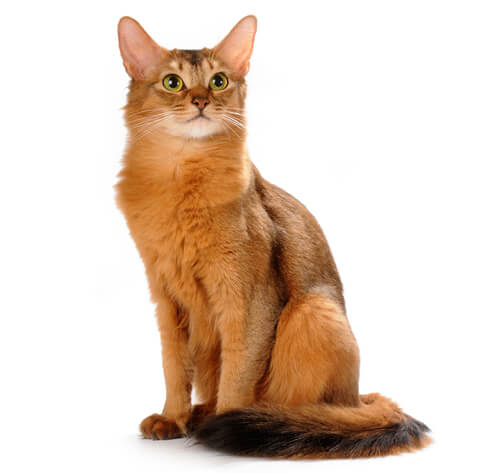
Strikingly beautiful, the Somali looks like a small wild fox with her full bushy tail and britches, large ears and dramatically ticked coat. This highly intelligent feline is known to open cupboards and fetch toys. The Somali loves attention and affection. The breed also is known for loving to play and having a zest for life. Highly adaptable, the Somali adjusts easily to new people and situations.
DID YOU KNOW? Contrary to popular belief, the Somali did not originate in Somalia. Rather, the breed is essentially a longhaired Abyssinian that resulted from a recessive gene. Originally, Abyssinian breeders were not happy when these longhaired kittens showed up in litters. It is believed the Somali resulted when longhaired cats were used by British Abyssinian breeders following World War II to repopulate the breed or possibly were due to a mutation.
The need-to-know
- Highly active and inquisitive cat
- Friendly but independent cat
- Very talkative cat
- Average build cat breed
- Requires grooming once a week
- Outdoor cat
- May require familiarisation before living with children
Personality

Somali cats are highly intelligent. The Somali breed is good natured and playful and enjoy games and toys. Somali cats may be shyer and more independent than their Abyssinian cousins but enjoy human company. They are active and enjoy access to outdoor exercise.
History and Origins

Country of Origin: USAThe Somali cat is the long haired version of the Abyssinian. The longhair gene was introduced into the Abyssinian breed in the early 1900s but the longhaired variety was not bred specifically until the 1960s. The original introduction of the longhaired gene took place in Britain and Abyssinians carrying the recessive gene were exported to Europe and America. Systematic breeding of the Somali cat began in America. Somalis soon became popular in other parts, particularly Australia where they are bred almost to the exclusion of the Abyssinian.
Nutrition and Feeding

Every cat is unique and each has their own particular likes, dislikes, and needs when it comes to food. However, cats are carnivores and every cat must obtain 41 different and specific nutrients from their food. The proportion of these nutrients will vary depending on age, lifestyle and overall health, so it's not surprising that a growing, energetic kitten needs a different balance of nutrients in her diet than a less active senior cat. Other considerations to bear in mind are feeding the right quantity of food to maintain 'ideal body condition' in accordance with feeding guidelines and catering to individual preference regarding wet or dry food recipes.
Other Information

Health and common issues
Although most Somali cats are healthy there are a few hereditary diseases which are known to appear in their near relative the Abyssinian and may, therefore, be linked to this breed too. Abyssinian cats can suffer from an inherited disease called pyruvate kinase deficiency that can cause anaemia. A reliable test is available for this and prospective owners should ask breeders if their cats have been tested and are clear of the problem. An eye problem, called progressive retinal atrophy, which causes progressive blindness has been indentified in some countries so it is worth asking the breeder about this as well.
Best cat breeds for children
While this breed is not widely recognised as one of the best breeds for children, all cats are different and with the proper familiarisation may still be able to live with children.